By Frank Iannamico
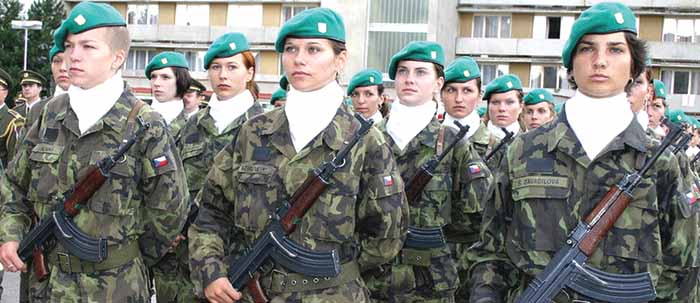
During 1938, the Germans occupied Czechoslovakia and it wasn’t long after the occupation began that Czech arms factories and workers were forced into manufacturing pistols, rifles and machine guns for the German war effort. After the war ended the Czech arms industry attempted to reestablish its prewar small arms manufacturing prominence primarily through export sales. Two customers of Czechoslovakia during the post war period were Yugoslavia and Israel. The sales were terminated for political reasons after the Communist coup d’état in 1948. After the coup, arms production in Czechoslovakia drastically changed as the Communists nationalized all of the small private arms firms in the country, joining all of the larger manufacturers that had previously been nationalized during the German occupation. Major changes were implemented during the Cold War period when production was drastically increased in anticipation of a third world war.

When the Warsaw Pact was formed during 1955, virtually all of the members adopted the Soviet designed 7.62x39mm SKS rifle in one form or another, except for Czechoslovakia, who had decided that they would design their own infantry rifle. By 1952, the Czechs developed and adopted a semiautomatic rifle designated as the vz.52. Not only was the rifle completely different from the SKS, it was chambered for a unique proprietary cartridge: the Czech M52, 7.62x45mm. The Czech cartridge had a longer case that was not interchangeable with the standard Warsaw Pact 7.62x39mm M43 round. The 7.62×45 round was slightly more powerful than the standard 7.62×39 cartridge, with a 131-grain bullet and a muzzle velocity of 2,495 feet per second. The cartridge remained in service from 1952 to 1957, when Czechoslovakia finally relented and adopted the far more common 7.62×39 round. The Czech vz.52 rifle was redesigned to chamber the Warsaw Pact standard 7.62×39 cartridge and newly designated as the vz.52/57 rifle.
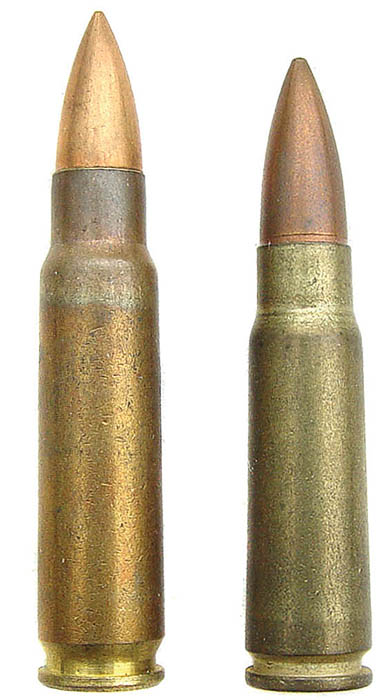
The Samopal vzor 1958 Rifle, 7.62x39mm
During the mid 1950s when Warsaw Pact members began to upgrade from the SKS semiautomatic rifle to the select-fire Soviet Kalashnikov AK-47 assault rifle, Czechoslovakia, due to national pride and a long tradition of weapons design and manufacture, once again resisted conforming with other Pact members. In January of 1955, under the leadership of Czech engineer Jiri Cermak, Czechoslovakia embarked on a program to design and develop their own unique assault rifle, based on an earlier weapon designed by Emanuel Holek in 1953, which had been inspired by the World War II German StG 44 rifle. Originally, the new weapon was designed for the Czech 7.62×45 cartridge, but for political reasons this was changed to the 7.62×39 round. The resulting weapon designated as the Samopal vzor 58 (Submachine gun Model 1958) which was developed, tested and subsequently adopted in 1958. The famous Ceska Zbojovka (CZ) plant, located in the town of Uhersky Brod, manufactured the rifle. The select-fire rifle outwardly bore some resemblance to the AK rifle, but internally it was far different. In addition to the standard fixed stock model, a folding stock variant and a model fitted with a night vision scope were produced.
There have been slight design changes noted that occurred during vz.58 production. It is estimated that most of the changes took place during the 1959-1961 era. All vz.58 receivers were marked with the year of manufacture.
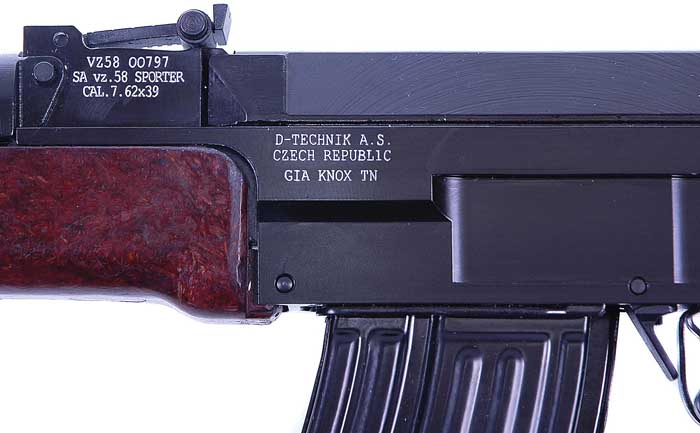
Front Sight Towers
There are at least three variations of the front sights; the earliest models have sight protector ears that are open at the top, and a flat base behind the sight tower. The second variation has open ears, but the back of the sight base has lightening cuts. The third variation has the lightening cuts at the base but the protector ears are closed at the top but with a hole to facilitate front sight elevation adjustments.
Furniture
Early vz.58 rifles were briefly fitted with wooden handguards, pistol grips and buttstocks. The wood was replaced by wood impregnated plastic.
Front Sling Swivels
Early front sling swivels are a round “key ring” design; later models use a simple T shaped stamping.
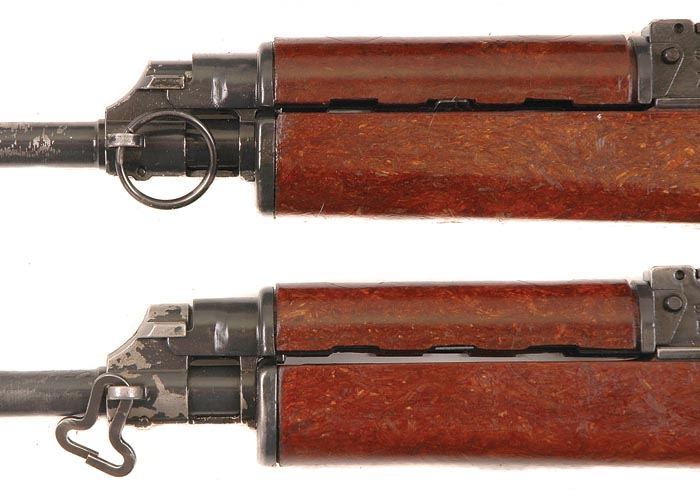
Trigger Guards
The early trigger guards have a single loop. Later manufacture are wider and have a guard on the right side for the magazine release lever. The trigger guards are sheet metal stampings.
Magazine Release Levers
The magazine levers are heavy machined steel. Early variants are rounded at the bottom while later levers were tapered and square at the bottom end for compatibility with the wider trigger guards.
Rear Sights
The hole at the front of the sight leaf on early production is round. Later models have a U shaped slot. The purpose of the hole/slot is to facilitate removal of the sight from the receiver. The rear sight leaf is a tangent type calibrated out to 800 meters. The 300-meter battle sight position is marked with a letter U.
Despite being members of NATO, the 7.62x39mm, vz.58 rifle is still in service with Czech Republic and Slovakian troops; although many have been upgraded with modern plastic furniture, optics, accessory rails and muzzle brakes.
Model Variations of the vz.58 Rifle
The Samopal vz.58P
The 7.62×39 vz.58P rifle, the suffix letter P representing “Pechotni” or infantry rifle, is the standard fixed stock model. The overall length is 33.26 inches (845mm) with a barrel length of 15.35 inches (390mm). The standard rifle weighs 7.91 pounds (3.59kg) with a loaded thirty-round magazine.
The Samopal vz.58V
A right-side folding metal stock version was subsequently introduced designated as the vz.58V, the suffix V representing “Vysadkovy” or airborne, and was developed for issue to troops requiring a more compact weapon. When extended, the overall length of the vz.58P is the same as the fixed stock model measuring 33.36 inches. When the stock is folded the overall length is reduced to 25.04 inches (636mm).

The Samopal vz.58Pi,
For night operations a special version of the vz.58 rifle was fielded. The weapon, designated as the vz.58 Pi, for “Pechotni infracervenym zamerovacem” which translates to “infantry with infrared sight” was fitted with a bipod, special flash suppressor and optics rail for mounting of the NSP-2 infrared night vision scope. The design had several drawbacks. One was the heavy battery required to power the unit, and the other was the capability of the enemy to detect infrared devices in use. This weapon has a fixed stock with the same dimensions of the vz.58P model.
The Select-Fire vz.58: How it Works
The vz.58 rifle has a forged/milled steel receiver and although its outward appearance superficially resembles the AK rifle, the weapons are completely different and no parts, to include the thirty-round magazines, are interchangeable.
The vz.58 is gas operated using a short-stroke piston design. The short-stroke system reduces the weight of the reciprocating parts, thus improving full-automatic accuracy and (theoretically) reducing felt recoil. The design also keeps carbon fouling produced by fired cartridges away from the internal components of the weapon. The disadvantages are a design that is more complex, and less reliable, than the long stroke gas piston and rotating-bolt systems found on the AK rifle.
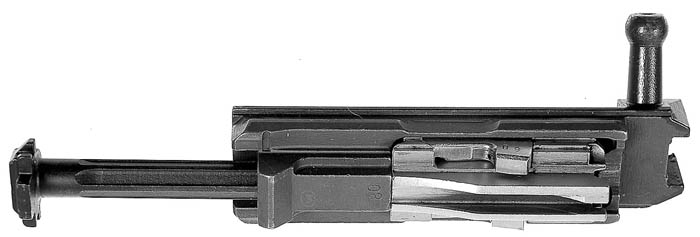
The bolt locking system of the vz.58 is completely different from the Kalashnikov rotating bolt system. In place of the rotating-bolt locking system used in the AK-47 design, the vz.58 incorporates a pivoting lock piece that locks the bolt assembly to the receiver. The pivoting lock fits under the bolt carrier. When the weapon is fired, the spring-loaded gas piston gives a short, stiff tap to the bolt carrier and after a rearward movement of approximately 22mm the bolt carrier swings the locking piece up from its recesses inside the receiver walls, unlocking the bolt, which on its rearward travel extracts and ejects the spent cartridge case. At the end of its rearward motion, the bolt carrier is thrust forward by the recoil spring. Upon its forward movement, the bolt stops after engaging the breech face, while the bolt carrier continues forward until the locking piece swings downward and locks into the recesses of the receiver. The vz.58 locking system is a combination of features found on both the Walther P-38 pistol and the Bren machine gun.
The vz.58 does not use a conventional hammer that strikes the firing pin; instead it utilizes a striker-fired design. A large striker cylinder is located in the rear machined-out portion of the bolt with its own spring that is positioned under the return spring of the bolt group. The striker has a lug that interacts with the sear, which is used to hold the striker in the cocked position. The trigger mechanism consists of two sears mounted side by side with one located 1.5mm forward of the other. The sear on the right side is connected to a sear trip operated by the carrier. Unless the bolt is fully forward and locked into battery, the trip holds up the right-hand sear and the striker is held back. The left-hand sear works in concert with a disconnector for semiautomatic operation.
The mode-of-fire selector is located on the right side of the receiver. When the selector is rotated to the full-automatic position, marked with a number 30, the disconnector is lowered and disengaged from the semiautomatic sear. When the carrier is fully forward, the right hand sear is depressed and the striker (hammer) is held on the semiautomatic sear only. As soon as the trigger is depressed, the trigger bar is moved forward and the left hand sear is depressed, releasing the striker. Each time the bolt recoils, the automatic sear rises upward and contains the striker until the bolt is locked in battery, after which the sear drops downward and the striker is released and impacts the firing pin in the bolt, firing the cartridge in the chamber. The cyclic rate of the vz.58 is considerably faster than the AK at 800 rounds per minute. The vz.58’s light weight and fast cyclic rate make it more difficult to control than an AKM in the full-automatic mode of fire.
When the selector is moved to the semiautomatic position, indicated by a number 1, the trigger bar is lowered and forced clear of the semiautomatic sear, and the disconnector rises to engage the semiautomatic sear. Pulling the trigger fires one round, the carrier recoils and the automatic sear rises. The carrier strikes the disconnector and lifts the semiautomatic sear. The striker is held rearward by the automatic sear, which is released when the carrier moves forward and since the automatic sear is located slightly behind the semiautomatic sear, the moving bolt is stopped by the semiautomatic sear. In order to fire another round the trigger must be fully released to allow the disconnector move back up to engage under the semiautomatic sear. The trigger can be pulled and the striker will be released by the semiautomatic sear. Both of the sears work off of a single multi-leaf flat style steel spring. In the semiautomatic mode of fire, the vz.58 is capable of slightly better accuracy over the average AK.
The weapon has a bolt hold-open feature that engages when the last round is fired from the magazine and the bolt remains rearward after the empty magazine is removed. There is also a bolt hold button alongside the magazine release lever. To release the bolt, the cocking handle is pulled slightly back and then released. The magazine release lever is located very close to the front of the trigger guard. The late manufacture trigger guard has a groove at the front and is bent inward on the left side to allow access to the lever. However, attempting to access the lever from the right side of the weapon is very difficult. The magazine has a thirty-round capacity, and is made from an aluminum alloy with an unloaded weight of only .42 pounds (.19kg), approximately one-half that of a standard steel AK magazine. The bolt carrier has a milled groove in it to enable the magazine to be loaded via stripper clips through the receiver. Furniture on early production models was wood; later replaced with wood impregnated plastic.
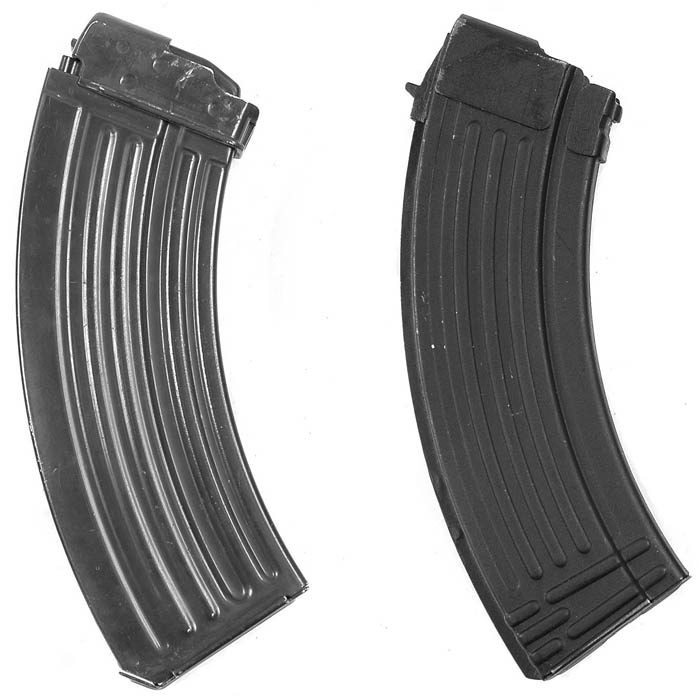
Approximately 920,000 vz.58 rifles were manufactured before production ended in 1984. Quantities of the Czech vz.58 rifles were procured by Cyprus, Angola, Ethiopia, Guinea, Libya, Mozambique, Somalia, Tanzania, Cuba and Guatemala. The weapon also appeared in the enemy’s hands during the Vietnam War. The vz.58 rifle still sees service in many Czech Republic and Slovakian military units. Today vz.58 rifles still in service with Czech and Slovak Republics have been observed with modern black plastic stocks and handguards.
The vz.58 in Hollywood
The vz.58 has appeared in several movies, although in many cases wasn’t recognized by viewers. One early appearance was in the 1987 film Full Metal Jacket. Wielding the vz.58 was the Vietnamese female sniper hiding in a building that shoots several Marines. She was eventually gunned down by Private Joker’s (Mathew Modine) partner Rafterman (Kevyn Major Howard) after Joker’s M16 jammed.
Another popular movie was Behind Enemy Lines (2001) in which many of the bad guys hunting down Navy Pilot Lt. Chris Burnett (Owen Wilson), carried vz.58 rifles.
Other films in which the vz appeared were; Octopussy, Lord of War and on TV in a CSI Miami episode.
The Semiautomatic vz.58 “Sporters”
An original select-fire vz.58 rifle is extremely rare as a transferable Class III firearm in the U.S. with only a handful of known examples in the NFA registry. Post ’86 examples have been available on occasion, but these are of course restricted and not available to the average collector. The good news is that the unique and handy rifles are available in semiautomatic-only form.
The Ohio Ordnance vz.2000
Ohio Ordnance was the first entity to offer a semiautomatic-only model of the vz.58 when they introduced their vz.2000 during the year 2000 (thus the nomenclature vz.2000). Although surplus vz.58 spare part sets were available and inexpensive, Ohio Ordnance had to design a completely new receiver that would accept their specially designed semiautomatic-only components, and could not readily be converted to function full-automatic. Lastly the design had to be approved by the BATF Technology Branch prior to commencing manufacture. One last hurdle was the original barrel length of the vz.58, which is only 15.35 inches (390mm) in length, just short of the BATF minimum of 16 inches. This would require the rifle to be designated as Short Barreled Rifle (SBR) subjecting it to NFA registration and accompanying $200 transfer tax. Ohio Ordnance avoided this by permanently fitting an extension to the muzzle bringing the barrel up to the required legal length. For the purist collector, Ohio Ordnance also offers their vz.2000 with the original length barrel as a short barrel rifle, although purchase of this model requires NFA registration and the payment of a $200 transfer tax. The vz.2000 comes with four spare magazines and carrying pouch, sling, bayonet, cleaning kit and both a fixed and folding stock.
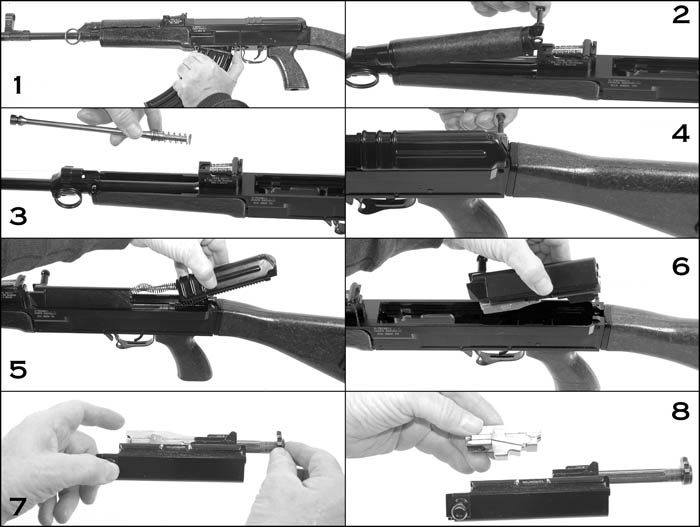
•1 Remove the magazine and visually inspect the chamber to insure the rifle is not loaded. •2 Slide out the retaining pin and lift off the top handguard. •3 Push the gas piston rearward to clear the gas block and tilt it upward for removal. •4 Slide out the top cover retaining pin. •5 Slide the top cover rearward until the recoil and striker springs clear their cavities in the bolt carrier. •6 Slide the bolt assembly rearward and lift it from the receiver. •7 Slide the striker rearward and rotate it for removal. •8 Remove the locking mechanism from the bolt.
CZ-USA vz.58 Sporters
In October 2007, CZ-USA announced their two new semiautomatic-only vz.58 rifles; the Tactical Sporter and the Military Sporter, available for sale in the U.S. The new rifles are manufactured by D-Technik a.s. Jablunka, Czech Republic.
The vz.58 Tactical Sporter
This model has a black synthetic buttstock with a cheek rest and slip-on rubber buttplate. The Tactical Sporter comes with two ten-round plastic single-stack magazines and a black nylon sling. The rifle cannot accept high-capacity magazines.
The vz.58 Military Sporter
This rifle is available with an original military fixed or folding buttstock and can accept original thirty-round magazines. To be compliant for import into the U.S., the rifle’s receivers are made so that they cannot accept a high-capacity magazine, and a barrel extension is added so that the barrel meets the BATF criteria. Once the rifles arrive at the importer’s facility, the trigger, sear, disconnector, magazine follower and floorplate are replaced with U.S. made components. This alteration allows the original military fixed and folding stocks to be used and the magazine well opened up to allow the original thirty-round magazines to be used.
The idea of a vz.58 Sporter rifle was conceived in part due to large stocks of vz.58 rifles and components that came from a sale of surplus equipment from the Army of the Czech Republic. Due to the incompatibility of the vz.58 with standard AK designs, and its limited distribution, the world market for rifles and spare parts was also limited. Other considerations included restrictions placed on Czech exports of military arms and ammunition.
The primary market targeted for the new rifle was the United States. One of the many obstacles facing the proposed vz.58 Sporter were the labyrinth of U.S. regulations and laws regarding the importation of foreign firearms into the country. The import issues were addressed by partnering with experienced importing companies in the U.S. Paramount were the problems of the vz.58’s barrel length, machine gun receiver and its ability to accept a high-capacity magazine. The most serious concern was the receiver, which had to be redesigned and then manufactured to prevent the possibility of accepting parts to permit automatic fire, and its ability to accept high-capacity magazines.
After a period of contemplation as to the validity of the concept it was decided to produce two prototypes in July of 2004. One of the prototype sporter rifles with specially designed single-stack, low capacity plastic magazine was sent to the BATF Technology Branch in the U.S. in an effort to seek approval of the design prior to beginning production. Approval of the project was finally received in early 2005. Pre-production preparations were made as the most labor intensive item was the receiver followed by the molds needed to produce the plastic magazines, sporter stock and handguards, which were made from Zytel 80G25HS. The magazine body was made from Tarflon PC, while other magazine components were produced using Zytel ST801.

During initial durability testing of the early pre-production guns a problem surfaced with the rifles occasionally misfiring. The source of the problem was pinned down to the disconnector. When cocking and releasing the bolt, the striker (hammer) was not always being held by the sear, but following the bolt into battery, a potentially dangerous situation. The problem was traced to the removal of the weapon’s original two-sear design, in particular the right hand sear. After a substantial period of investigation the technician in charge of the project, Mr. Vladimir Zemanek, discovered that the basic problem was that the premature engagement of the disconnector and sear resulting in the sear not engaging the striker to hold it rearward until the trigger is pulled. The solution was to hold the disconnector down for a fraction of a second longer. This was achieved by welding a small plate along the left side of the bolt carrier. The technical solution that solved the aforementioned problems are currently patent pending and is the reason for the patent pending notation engraved on the side of the receiver. Finally, with all of the legal and technical problems addressed, production of the vz.58 Sporter in Czechoslovakia began in January of 2006. The strict Czech military quality control procedures have been applied to all raw material and production procedures.
The rifles are first phosphated and then finished with gray or black enamel paint. Once the rifles were imported in to the U.S., the required number of American manufactured components were added to make the rifles complaint with U.S. laws enabling the original stocks, pistol grips and handguards to be fitted and the receiver modified to accept original thirty-round magazines.
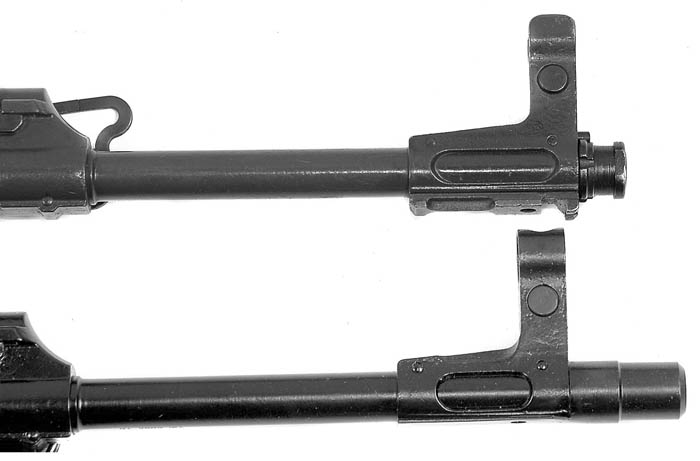
Their latest Czech made semiautomatic-only variants are assembled on a newly designed CNC milled receiver and semiautomatic trigger mechanism and fire control components. The barrel had a threaded extension permanently attached to the muzzle to extend the length to 16.14 inches in order to keep it legal for U.S. sales. There is no provision for mounting a bayonet. The remainder of the parts used in the CZ Sporters are original military. The rifles come with one original aluminum alloy magazine, refitted with U.S. made Zytel floorplates and follower for compliance purposes, a cleaning kit and a CD that includes a complete owner’s manual and a brief history about the rifle.
Rapid Fire LLC
The latest offering of the vz.58 rifle is a milled receiver manufactured and sold by Rapid Fire LLC of Troy Ohio. The receiver is machined from a solid block of 4140 steel and is available for those who wish to assemble their own vz.58 rifle from a surplus part set. Rapid Fire also offers a U.S. made semiautomatic fire control parts group and gas piston to keep the build compliant with federal laws. Although Rapid Fire currently only sells their receiver and trigger group parts they plan to offer complete rifles built on their receivers in the future.

Resources
VZ 2000 Rifles
Ohio Ordnance Works, Inc
PO Box 687
Chardon, Ohio 44024
Phone: (440) 285-3481
www.ohioordnanceworks.com
vz.58 Sporter Rifles
Czech Point USA
103 Stone Road
Knoxville, TN. 37920
Phone: (865) 247-0184
Tennessee Guns International
PO Box 787
Louisville, TN 37777
info@tnguns.com
Centerfire Systems Inc.
102 Fieldview Dr.
Versailles, KY 40383
Phone (800) 950-1231
info@centerfiresystems.com
vz.58 Receivers and Compliance Parts
Rapid Fire LLC
1285 Archer Drive
Troy, Ohio
Phone: (937) 332-0833
Website: http://www.ohiorapidfire.com/
| This article first appeared in Small Arms Review V12N10 (July 2009) |










